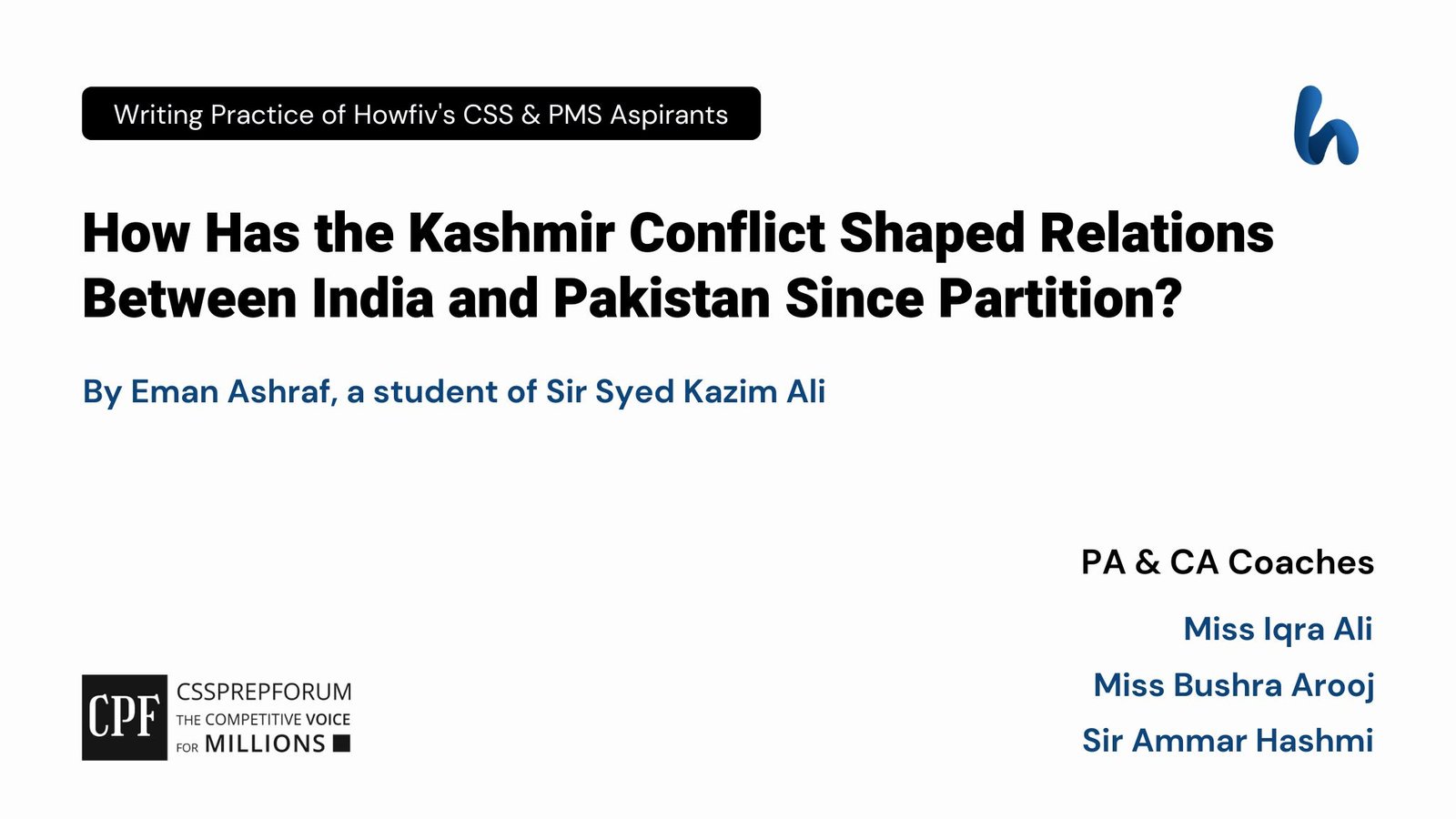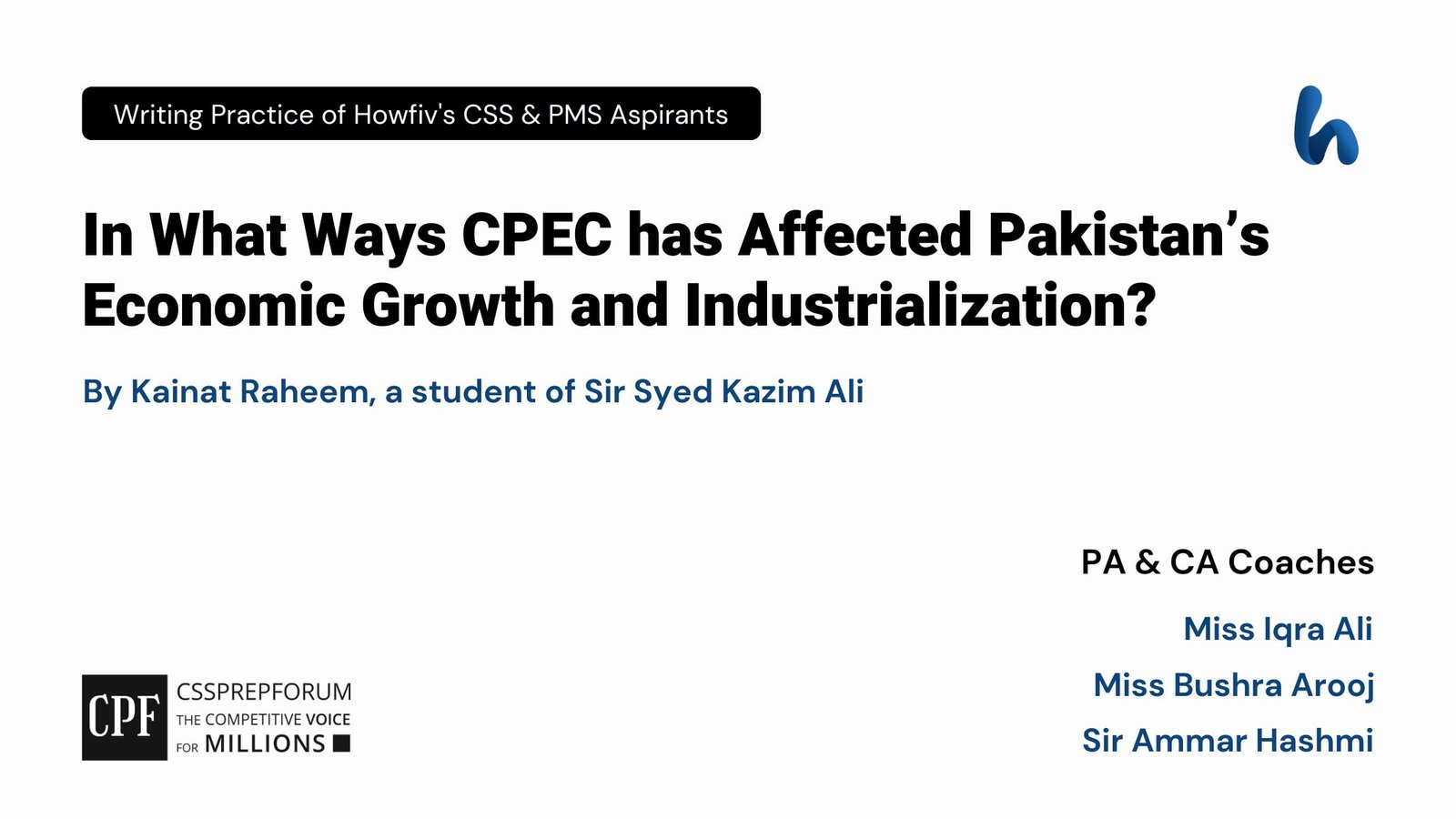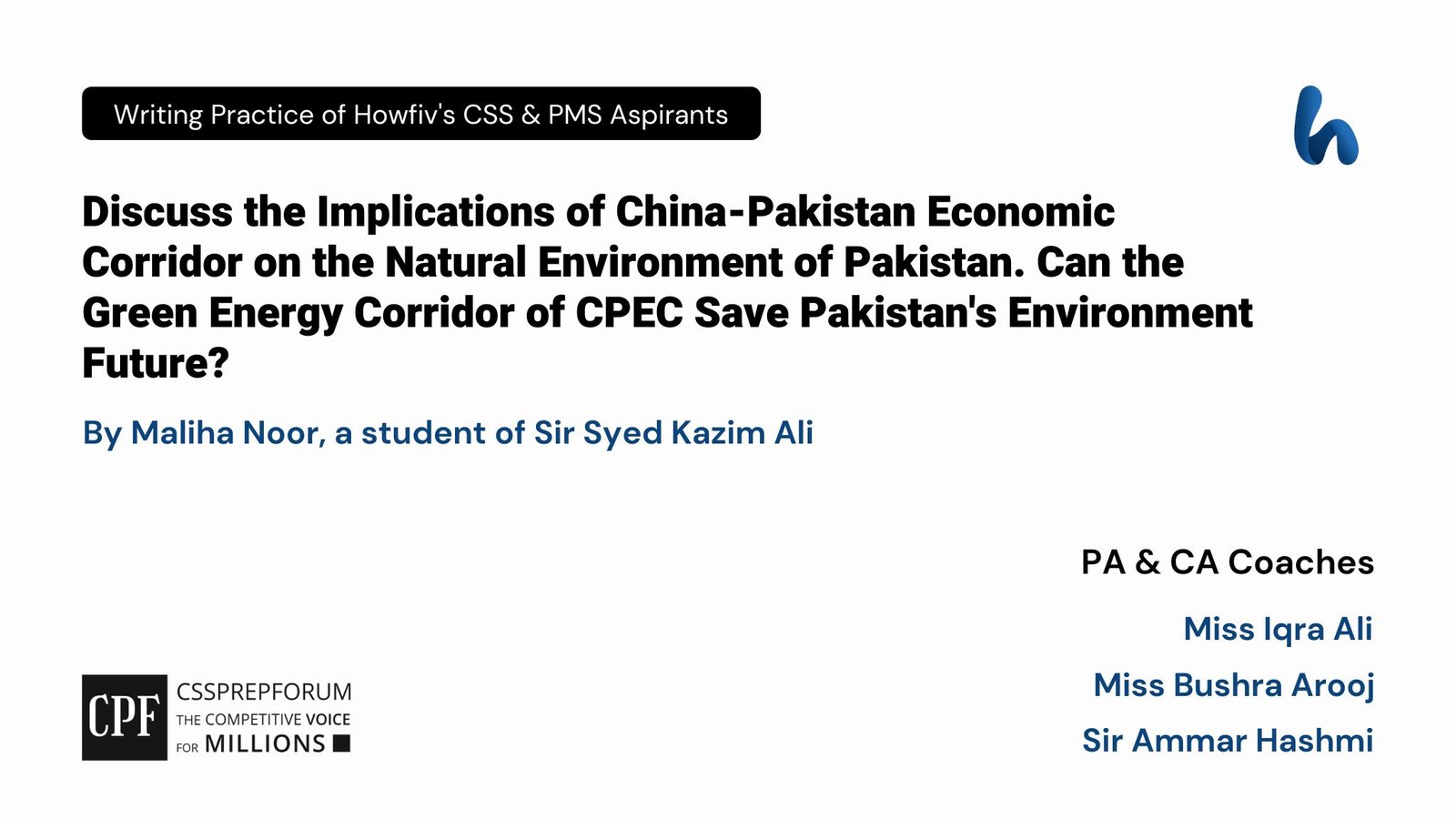CSS 2023 Solved Essay | Instruction in Youth is Like Engraving in Stone
Bilal Ahmad, a Sir Syed Kazim Ali student, has attempted the CSS 2023 essay “ Instruction in youth is like engraving in stone ” on the given pattern, which Sir Syed Kazim Ali teaches his students. Sir Syed Kazim Ali has been Pakistan’s top English writing and CSS, PMS essay and precis coach with the highest success rate of his students. The essay is uploaded to help other competitive aspirants learn and practice essay writing techniques and patterns to qualify for the essay paper.

Outline
1- Introduction
- ✓ Education is often hailed as the cornerstone of societal progress, a catalyst for personal growth, and a key determinant of an individual’s success.
- ✓ In the journey of knowledge acquisition, the youth hold a special place, as their minds are malleable, eager, and receptive to the guidance they receive.
- ✓ The lessons imprinter upon the young minds and shape their perspectives, aspirations, and future endeavours.
2- Understanding the phrase “instruction in youth is like engraving in stone
3- How is instruction in youth like engraving in stone?
- ✓ Personal and professional development
- Evidence: According to the Global Partnership for Education (GPE), instruction during the early year’s acts as a catalyst for personal development, influencing the way young minds perceive the world, develop critical thinking skills, and form their belief systems.
- ✓ Ethical decision making and character development
- Evidence: According to the Association for Moral Education, youth exposed to consistent ethical instruction exhibit greater self-control, empathy, and a stronger sense of responsibility.
- ✓ Foundation for lifelong learning
- Evidence: According to the National Institute for Early Education Research (NIEER), early education and instruction play a pivotal role in cognitive and socio-emotional development, setting the stage for continuous growth and success in various aspects.
- ✓ Diverse perspectives and inclusivity
- Evidence: According to the survey conducted by the University of California, a robust educational system has the potential to nurture inclusive minds, laying the foundation for diverse societies that embrace differences rather than fear them.
- ✓ Resilience through facing challenges
- Evidence: According to the National Scientific Council on the Developing Child (NSCDC), nurturing resilience in children through educational experiences helps build a strong foundation for their lifelong success.
4- Challenges in instruction in youth
- ✓ Limited access to quality education
- ✓ socioeconomic disparities
- ✓ Balancing traditional and modern approaches
5- Remedial measures to overcome challenges
- ✓ To ensure positive and accurate instruction
- ✓ To address biases and promote diversity
- ✓ To harness technology for effective instruction
6- Critical analysis
7- Conclusion

Education is often hailed as the cornerstone of societal progress, a catalyst for personal growth, and a key determinant of an individual’s success. In the journey of knowledge acquisition, the youth hold a special place, as their minds are malleable, eager, and receptive to the guidance they receive. Moreover, during the formative period, instruction leaves an indelible mark, akin to engraving in stone. The lessons imprinted upon the young minds shape their perspectives, aspirations, and future endeavours. Like a master sculptor chiselling away at a block of marble, educators and mentors play a pivotal role in honing the next generation’s intellectual, emotional, and moral faculties. The impact of these teachings extends far beyond the immediate moment, reaching into the future as these individuals grow and contribute to society. In addition, the power of instruction lies not only in the transfer of information but also in its ability to foster critical thinking, instil moral values, foster personal and professional growth, promote ethical decision-making, and stimulate diverse perspectives and inclusivity. However, in a world driven by constant change and evolving ideas, instruction in youth faces a myriad of challenges, such as limited access to quality education and socioeconomic disparities. To address these challenges and further enhance the role of instruction in youth, several remedial measures should be considered. These measures ensure positive and accurate instructions, address biases, and promote inclusivity. Hence, effective instruction in youth stretches far beyond the confines of the classroom, permeating every aspect of an individual’s life and shaping the trajectory of their future endeavours.
To begin with, it is pertinent to understand the proverb, “Instruction in youth is like engraving in stone.” The phrase implies that the lessons and teachings imparted during one’s formative years have a profound and lasting impact. Just as an inscription carved into stone is enduring and difficult to alter, the knowledge and values instilled in young minds tend to remain deeply ingrained throughout their lives. Moreover, the analogy emphasizes the importance of providing quality education and moral guidance during childhood, as it lays a strong foundation that influences their growth, decision-making, and character in the long run.
Just as ancient civilizations engraved their wisdom and knowledge into stone tablets for posterity, the instructions provided to youth can often have a lasting and profound impact on their development and future endeavors. To begin with, the significance of instruction in youth is often compared to an engraving in stone, leaving an indelible mark on young mind that guides their personal and professional development throughout life. During formative years, individuals acquire fundamental knowledge, skills, and values that shape their future trajectories. Education equips them with essential cognitive abilities, critical thinking, and problem solving skills, nurturing their intellectual growth. This foundation extends to personal development by instilling values like discipline, responsibility, and ethics, which guide their interactions and decisions. According to the Global Partnership for Education (GPE), instruction during the early years acts as a catalyst for personal development, influencing the way young minds perceive the world, develop critical thinking skills, and form their belief systems. Thus, in the realm of personal and professional growth, youth instruction holds a crucial position, firmly etching essential values and knowledge in the hearts and minds of young earners.
In addition, in the landscape of human development, the foundation laid during youth serves as bedrock for character formation and ethical decision-making. This formative period is akin to chiseling stone, where the right tools and guidance create enduring imprints. Instruction in youth shapes character by instilling virtues such as honesty, empathy, and responsibility. Exposure to diverse perspectives and ethical dilemmas enhances cognitive and emotional growth, enabling individuals to navigate complex moral landscapes with integrity. As they encounter challenges, the foundation laid during youth serves as a compass for ethical behavior. According to the Association for Moral Education, youth exposed to consistent ethical instruction exhibit greater self-control, empathy, and a stronger sense of responsibility. Hence, the process of engraving ethical values into young hearts and minds plays a pivotal role in shaping individuals’ choices throughout their lives.
Further, education, particularly during one’s formative years, can be linked to the art of engraving in stone. Just as a skilled artisan carefully etches intricate designs onto solid rock, imparting knowledge and wisdom to the youth lays the groundwork for a lifetime of continuous learning and growth. The formative years of a person’s life provide a crucial window of opportunity for absorbing knowledge, developing critical thinking skills, and cultivating a curious mindset. A solid education foundation not only equips individuals with essential information and academic skills but also fosters the capacity to adapt, innovate, and engage with the rapidly evolving world. According to the National Institute for Early Education Research (NIEER), early education and instruction play a pivotal role in cognitive and socio-emotional development, setting the stage for continuous growth and success in various aspects. This early investment in learning paves the way for a more informed, adaptable, and intellectually enriched adulthood, enhancing personal growth and societal progress. So, by laying the groundwork for a solid educational foundation, early instruction paves the way for lifetime learning and development.

Moreover, in the ever changing landscape of our globalized world, education stands as a beacon of hope, guiding young individuals towards inclusivity and diverse perspectives. As children learn and grow, their educational experiences leave indelible imprints that shape their attitudes, beliefs, and interactions with others. As young minds are impressionable and open to new ideas, providing them with comprehensive and unbiased education encourages the development of a tolerant and accepting mindset. Exposure to a wide range of cultures, histories, and viewpoints cultivates an understanding of the richness that diversity brings, promoting empathy and reducing prejudices. According to the survey conducted by the University of California, a robust educational system has the potential to nurture inclusive minds, laying the foundation for diverse societies that embrace differences rather than fear them. Hence, through education, the potential for future generations to celebrate diversity and actively engage with different perspectives is heightened, creating a more compassionate and inclusive global community.
Last but not least, the journey of life is riddled with obstacles and adversities, and it is education in youth that acts as a stalwart companion, instilling resilience and strength to weather the storms. Through structured guidance, they learn to confront difficulties head-on, acquiring essential problem-solving skills and emotional coping mechanisms. As they navigate these challenges, whether academic, personal, or social, they develop a sense of adaptability and tenacity. The guidance provided by mentors and educators enables them to understand that setbacks are opportunities for growth, not insurmountable obstacles. According to the National Scientific Council on the Developing Child (NSCDC), nurturing resilience in children through educational experiences helps build a strong foundation for their lifelong success. Hence, education systems that prioritize holistic development and resilience-building have a positive impact on students’ overall well-being.
As we delve deeper into the realm of instruction in youth, it becomes apparent that various challenges and complexities lie ahead. To begin with, access to education plays a pivotal role in shaping the future of any nation, as it equips the youth with the knowledge, skills, and opportunities necessary for personal and societal growth. However, a major hindrance faced by youth in their educational journey is limited access to education. In many developing regions around the world, children and adolescents lack proper infrastructure, quality schools, and well-trained teachers. Economic disparities amplify these challenges, as marginalized communities often lack the financial means to access quality education, perpetuating cycles of inequality. Therefore, the absence of these essential components restricts the potential of young minds and hampers their ability to pursue their dreams and aspirations. Hence, efforts are essential to empower youth with the knowledge and skills needed to navigate an increasingly complex world.
Moreover, socioeconomic disparities significantly limit the quality of youth education, perpetuating a cycle of inequality. In lower-income communities, schools often lack the necessary resources and funding to provide a well-rounded education. Limited access to education resources hampers their ability to explore their full potential, stifling cognitive and socio-emotional growth. In addition, the impact of socioeconomic disparities on youth education extends beyond the classroom. Economic hardship can result in increased stress and instability within families, affecting children’s overall well-being and hindering their ability to focus on their studies. These challenges can engender a cycle of underachievement, limiting opportunities for higher education and future career prospects.
Last but not least, balancing traditional and modern approaches in youth instruction poses a complex challenge. Traditional methods draw from proven practices but might fail to engage modern learners accustomed to interactive and technology-driven experiences. Modern approaches leverage technology and real world relevance, yet they could overlook the wisdom of time-tested pedagogies. Striking the right balance requires understanding the learning styles and preferences of today’s youth while respecting the value of foundational methods. Incorporating interactive tools, multimedia, and experiential learning can enhance engagement without discarding traditional frameworks.
In light of the challenges identified, it is essential to explore and implement effective remedial measures to address these issues and pave the way for lasting improvement. To begin with, when providing instruction to youth, it is essential to adopt a positive and encouraging approach. Positivity refers to a nurturing learning environment that enables young learners to feel comfortable and motivated to tackle challenges. On the other hand, to ensure accuracy in youth instruction, educators must first have a solid grasp of the subject matter themselves. Moreover, incorporating real-life examples and practical applications can enhance understanding and make learning more meaningful for youth.
In addition, addressing biases and promoting diversity are essential to overcoming challenges in youth instruction. Educators must recognize and confront their own biases to create an inclusive learning environment. By acknowledging and understanding their prejudices, teachers can better avoid favoritism and ensure that all students receive fair treatment and opportunities. Besides, instructors should strive to incorporate diverse perspectives, voices, and experiences into their teaching materials and classroom discussions. Promoting diversity goes beyond demographics and involves integrating diverse teaching methodologies that accommodate different learning styles and abilities. This approach enhances engagement and knowledge retention among all students. Moreover, providing safe spaces for open dialogue about identities and experiences empowers young individuals to express themselves and learn from one another. By doing so, they can foster empathy, cultural awareness, and a sense of belonging among the youth, encouraging them to embrace diversity as a strength rather than a barrier.
Last but not least, leveraging technology to enhance instruction is a pivotal remedial measure for addressing challenges faced in youth education. In the modern era, where technology is ubiquitous, integrating it into education can significantly amplify learning outcomes. Technology provides personalized learning opportunities, catering to diverse learning styles and paces. Interactive digital platforms offer engaging content through multimedia and simulations, captivating the attention of youth who are accustomed to digital interference. Further, technology enables remote and flexible learning, transcending geographical barriers and accommodating individual schedules. This is especially beneficial for youth who struggle with conventional classroom settings due to various reasons. Virtual classrooms, video conferencing, and online collaboration tools foster peer interaction and active participation. Data analytics and AI-driven tools help educators identify learning gaps, enabling timely intervention and personalized support.
To articulate critically, the analogy that instruction in youth is akin to engraving in stone captures the enduring and transformative impact of early learning experiences. Just as etching on stone leaves an indelible mark, the knowledge, values, and skills imparted during one’s formative years become deeply ingrained, shaping the foundation upon which individuals build their lives. This notion underscores the critical role of education and guidance during youth, as it molds character, fosters intellectual curiosity, and establishes a framework for lifelong growth. However, while the comparison emphasizes the lasting nature of early instruction, it also underscores the need for careful and thoughtful guidance. Just as flawed engravings on stone cannot be easily erased, improper or misleading education can lead to long-term consequences. Thus, educators, parents, and society at large must recognize their collective responsibility to provide accurate, balanced, and empowering guidance to the young generation. Ultimately, the saying serves as a reminder that the impressions made during youth are profound and far-reaching, carrying the potential to shape individuals and societies for generations to come.
In conclusion, the adage “Instruction in youth is like engraving in stone underscores the profound impact of early education on shaping individuals’ character and potential. Just as etchings on stone endure the test of time, the lessons and values instilled during one’s formative years leave an indelible mark on one’s life. Investing in comprehensive and thoughtful education for the youth yields far-reaching consequences, not only for personal development but also for the progress of societies.
CSS Solved Past Papers’ Essays
Looking for the last ten years of CSS and PMS Solved Essays and want to know how Sir Kazim’s students write and score the highest marks in the essays’ papers? Then, click on the CSS Solved Essays to start reading them. CSS Solved Essays
CSS 2023 Solved Essays
Are you searching for CSS 2023 solved essays by Sir Syed Kazim Ali’s students? Click on any of the topics to start reading the solved essays.
| 1- Instruction in youth is like engraving in stone |
| 2- The one who uses force is afraid of reasoning |
| 3- Not all recycling projects are cost-effective |
| 4- The fool speaks, and the wise listen |
| 5- A friend walks in when everyone else walks out |
| 6- Online learning is not only convenient but often more effective than traditional classroom instruction |
| 7- To encourage healthy eating, higher taxes should be imposed on soft drinks and junk food |
| 8- People have become overly dependent on technology |
| 9- Both parents should assume equal responsibility in raising a child |
| 10- Boys will be boys |
CSS Solved General Science & Ability Past Papers
Want to read the last ten years’ General Science & Ability Solved Past Papers to learn how to attempt them and to score high? Let’s click on the link below to read them all freely. All past papers have been solved by Miss Iqra Ali & Dr Nishat Baloch, Pakistan’s top CSS GSA coach having the highest score of their students. General Science & Ability Solved Past Papers
Articles Might Interest You!
The following are some of the most important articles for CSS and PMS aspirants. Click on any to start reading.












